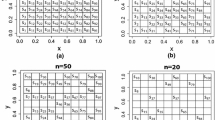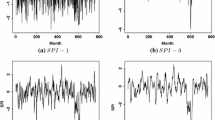Abstract
In this paper, we propose a geostatistical model for the counting process using a non-homogeneous Poisson model. This work aims to model the intensity function as the sum of two components: spatial and temporal. The spatial component is modeled using a Gaussian process in which the covariance structure is assumed to be anisotropic. Anisotropy is incorporated by applying a spatial deformation approach. The temporal component is modeled in such a way that its behavior concerning time has the structure of a Goel process. The inferences for the proposed model are obtained from a Bayesian perspective. The parameter estimation is obtained using Markov Chain Monte Carlo methods. The proposed model is adjusted to a set of real data, referring to the rain precipitation in 29 monitoring stations, distributed in the states of Maranhão and Piauí, in the northeast region of Brazil, in 31 years, from 01/01/1980 to 12/31/2010. The objective is to estimate the frequency of rain that exceeded a certain threshold.





Similar content being viewed by others
References
Achcar, J.A., Dey, D.K., Niverthi, M.: A Bayesian approach using nonhomogeneous Poisson processes for software reliability models. In: Basu, A.P., Basu, K.S., Mukhopadhyay, S. (eds.) Frontiers in Reliability, pp. 1–18 World Scientific, Singapore (1998)
Adámoli, J., Macêdo, J., Azevedo, L., Netto, J.: Caracterização da região dos cerrados. Solos dos cerrados: tecnologias e estratégias de manejo p 33 – 98 (1987)
Alho, C.J.R., Martins, E.S.: De grão em grão, o Cerrado perde espaco. WWF-Fundo Mundial para a Natureza, Brasília (1995)
Bivand, R., Lewin-Koh, N.: maptools: Tools for Handling Spatial Objects (2019). https://CRAN.R-project.org/package=maptools, r package version 0.9-5
Bruno, F., Guttorp, P., Sampson, P., Cocchi, D.: A simple non-separable, non-stationary spatiotemporal model for ozone. Environ. Ecol. Stat. 16, 515–529 (2008). https://doi.org/10.1007/s10651-008-0094-8
Cifuentes-Amado, M., Cepeda-Cuervo, E.: Non-homogeneous poisson process to model seasonal events: application to the health diseases. Int. J. Stat. Med. Res. 4, 337–346 (2015). https://doi.org/10.6000/1929-6029.2015.04.04.4
Cox, D.R.: Some statistical methods connected with series of events. J. R. Stat. Soc. Ser. B (Methodological) 17(2), 129–164 (1955)
Damian, D., Sampson, P., Guttorp, P.: Bayesian estimation of semi-parametric non-stationary spatial covariance structure. Environmetrics 12, 161–178 (2001). https://doi.org/10.1002/1099-095X(200103)12:2<161::AID-ENV452>3.0.CO;2-G
Dryden, I., Mardia, K.: Statistical Shape Analysis. Wiley Series in Probability and Statistics. Wiley, Chichester (1998)
Fouedjio, F., Desassis, N., Romary, T.: Estimation of space deformation model for non-stationary random functions. Spatial Stat. 13, 45–61 (2015). https://doi.org/10.1016/j.spasta.2015.05.001
Gelman, A., Rubin, D.B.: Inference from iterative simulation using multiple sequences. Stat Sci 7, 457–472 (1992). https://doi.org/10.1214/ss/1177011136
Goel, A.: A guidebook for software reliability assessment, p. 1983. Ft, Belvoir Defense Technical Information Center AUG (1983)
Gomes, H.B., Ambrizzi, T., Herdies, D.L., Hodges, K., Silva, B.F.: Easterly wave disturbances over northeast brazil: an observational analysis. Adv. Meteorol. 2015, 1–20 (2015). https://doi.org/10.1155/2015/176238
Hastings, W.K.: Monte carlo sampling methods using markov chains and their applications. Biometrika 57(1), 97–109 (1970)
Ingebrigtsen, R., Lindgren, F., Steinsland, I.: Spatial models with explanatory variables in the dependence structure. Spatial Stat. 8, 20–38 (2014). https://doi.org/10.1016/j.spasta.2013.06.002
Kendall, D.G.: Shape manifolds, procrustean metrics, and complex projective spaces. Bull. Lond. Math. Soc. 16, 81 (1984)
Kuo, L., Yang, T.: Bayesian computation for nonhomogeneous poisson processes in software reliability. J. Am. Stat. Assoc. 91, 763–773 (1996). https://doi.org/10.1080/01621459.1996.10476944
Lawson, A.: Bayesian Disease Mapping: Hierarchical Modeling in Spatial Epidemiology (2009). https://doi.org/10.1201/9781584888413
Marengo, J.A., Nobre, C.A.: Clima da região amazônica. in: Cavalcanti, i. f. a. (org.). tempo e clima do brasil. São Paulo: Oficinas de Textos, pp. 198–212 (2009)
Marengo, J.A., Rodrigues, R., Alves, L.: Drought in northeast brazil–past, present, and future. Theor. Appl. Climatol. 129, 1189–1200 (2017). https://doi.org/10.1007/s00704-016-1840-8
Mendonca, F., Danni-Oliveira, I.M.: Climatologia: Noções básicas e climas do brasil, pp. 198–206. Oficinas de Textos, São Paulo (2007)
Metropolis, N., Rosenbluth, A.W., Rosenbluth, M.N., Teller, A.H., Teller, E.: Equation of state calculations by fast computing machines. J. Chem. Phys. 21(6), 1087–1092 (1953). https://doi.org/10.1063/1.1699114
Moller, J., Syversveen, A.R., Waagepetersen, R.P.: Log gaussian cox processes. Scand. J. Stat. 25, 451–482 (1998). https://doi.org/10.1111/1467-9469.00115
Morales, F., Gamerman, D., Paez, M.: State space models with spatial deformation. Environ. Ecol. Stat. 20, 191–214 (2013). https://doi.org/10.1007/s10651-012-0215-2
Morales, F., Vicini, L., Hotta, L.K., Achcar, J.: A nonhomogeneous poisson process geostatistical model. Stoch. Environ. Res. Risk Assessment 31, 493–507 (2017). https://doi.org/10.1007/s00477-016-1275-x
Nascimento, FdC, Braga, C.C., Araújo, F.R.: Análise estatística dos eventos secos e chuvosos de precipitação do estado do maranhão. Rev. Bras. Meteorol. 32, 375–386 (2017). https://doi.org/10.1590/0102-77863230005
Oliveira, P.T., Santos e Silva, C.M., Lima, K.C.: Climatology and trend analysis of extreme precipitation in subregions of northeast brazil. Theor. Appl. Climatol. 130, 77–90 (2017)
Plummer, M., Best, N., Cowles, K., Vines, K.: Coda: convergence diagnosis and output analysis for mcmc. R News 6(1), 7–11 (2006)
R Core Team.: R: A Language and Environment for Statistical Computing. R Foundation for Statistical Computing, Vienna, Austria (2019). https://www.R-project.org/
Reddy, S.J.: Climatic classification: the semi-arid tropics and its environment: a review. Pesquisa Agropecuária Bras. 18, 823–847 (1983)
Rodrigues, D.T., Goncalves, W.A., Spyrides, M.H., Santos e Silva, C.M.: Spatial and temporal assessment of the extreme and daily precipitation of the tropical rainfall measuring mission satellite in northeast brazil. Int. J. Remote Sens. (2019). https://doi.org/10.1080/01431161.2019.1643940
Rodrigues, E., Gamerman, D., Tarumoto, M., Tzintzun, G.: A non-homogeneous poisson model with spatial anisotropy applied to ozone data from mexico city. Environ. Ecol. Stat. 22, 393–422 (2014). https://doi.org/10.1007/s10651-014-0303-6
Sampson, P.D., Guttorp, P.: Nonparametric estimation of nonstationary spatial covariance structure. J. Am. Stat. Assoc. 87(417), 108–119 (1992)
Schmidt, A., Gelfand, A.: A bayesian coregionalization approach to multivariate pollutant data. J. Geophys. Res. (2003). https://doi.org/10.1029/2002JD002905
Schmidt, A., O’Hagan, A.: Bayesian inference for non-stationary spatial covariance structure via spatial deformations. J. R. Stat. Soc. Ser. B 65, 743–758 (2003). https://doi.org/10.1111/1467-9868.00413
Schmidt, A., Guttorp, P., O’Hagan, A.: Considering covariates in the covariance structure of spatial processes. Environmetrics 22, 487–500 (2011). https://doi.org/10.1002/env.1101
Vicini, L., Hotta, L.K., Achcar, J.: Non-homogeneous poisson process in the presence of one or more change-points: an application to air pollution data. J. Environ. Stat. 5, 1–22 (2013)
Author information
Authors and Affiliations
Corresponding author
Additional information
Publisher's Note
Springer Nature remains neutral with regard to jurisdictional claims in published maps and institutional affiliations.
Appendices
The code of the model proposed
In this appendix, we show how to implement the model in the software R Core Team (2019). We developed the Metropolis–Hastings steps in Sect. 4. We highlight that to execute the instructions described in this appendix, the user must have some experience with the software R. Although in this appendix the program is used with extreme rain data in Maranhão and Piauí, it can be adapted for any other data set. Before starting to explain how to run the code, create a folder named Model in the directory C and download data.RData, Function.R, and Main.R in this one. The file data.RData has the calendar times when extreme rains occurred for each the monitoring stations distributed in the states of Maranhão and Piauí, and the geographical coordinates of each monitoring station. The Function.R file is the script of the functions that are necessary to run the MCMC method. Finally, the file Main.R contains the script of the main program; in this file the user determines the number of iterations, burn-in, jumps, and the values of the hyperparameters of the prior distributions of the parameters.
1.1 Steps
1.1.1 Step 1
In the first step, the user opens the data.RData file. There are several ways to do this, one of which is to use the following command.

Once the previous command has been executed, the user has access to the extreme rainfall data and the geographical coordinates of the locations. The extreme rainfall data are recorded in the matrix “data,” and the geographical coordinates are recorded in the matrix “site.” If the user runs the command  in the R console will appear
in the R console will appear

In the ith column of the matrix, “data” recorded the calendar times of the extreme rain corresponding to the ith monitoring station. The number of rows in the matrix “data” is equal to the maximum of the frequencies of extreme rainfall that occurred at the monitoring stations. The number of columns in the matrix “data” is equal to the number of monitoring stations.
1.1.2 Step 2
In this step, the user loads the functions to carry out the algorithm by executing the following command

1.1.3 Step 3
In this stage, the user determines the number of iterations, burn-in, and hyperparameters of the prior distributions of the parameters. These specifications are stored in Main.R.

For example, in the previous script, the user has determined 350000 iterations, burn-in 250000, and prior distributions \(\beta \sim G(0.001,0.001)\), \(\alpha \sim G(0.001,0.001)\).
1.1.4 Step 4
Finally, the user runs the MCMC algorithm using the following command

Output
At the end of running the algorithm, the user will have access to the chains produced by the MCMC method. In the following, we show the output produced by the algorithm:
-
Malpha is a vector that has samples of the posterior distribution of \(\alpha \).
-
Mbeta is a vector that has samples of the posterior distribution of \(\beta \).
-
Mb is a vector that has samples of the posterior distribution of \(\phi \).
-
Mv is a matrix that has samples of the posterior distribution of v’s.
-
MPsi is a matrix that has samples of the posterior distribution of \(\varPsi \).
-
MW is a matrix that has samples of the posterior distribution of W.
-
MD1 is a matrix that has samples of the posterior distribution of the component of x in the space D.
-
MD2 is a matrix that has samples of the posterior distribution of the component of y in the space D.
The user has the statistical and graphical tools of R to perform inferential analysis on the parameters of the model. For example, the user can use the coda package (Plummer et al. 2006) for performing the posterior distribution convergence diagnosis. Likewise, the user can use packages graphics (R Core Team 2019) and maptools (Bivand and Lewin-Koh 2019) to graph the surfaces of extreme rainfall frequency and variance surface. Finally, we present the code in R to graph the variance surface.

Rights and permissions
About this article
Cite this article
Morales, F.E.C., Vicini, L. A non-homogeneous Poisson process geostatistical model with spatial deformation. AStA Adv Stat Anal 104, 503–527 (2020). https://doi.org/10.1007/s10182-020-00373-6
Received:
Accepted:
Published:
Issue Date:
DOI: https://doi.org/10.1007/s10182-020-00373-6




